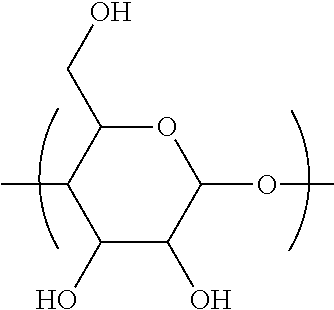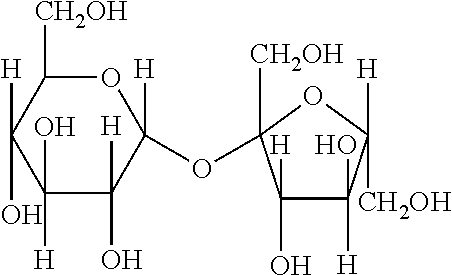Process for synthesizing c5+ hydrocarbons in the presence of a catalyst prepared using at least one cyclic oligosaccharide
a technology of cyclic oligosaccharide and catalyst, which is applied in the direction of organic compound/hydride/coordination complex catalyst, physical/chemical process catalyst, metal/metal-oxide/metal-hydroxide catalyst, etc., can solve the problem of mediocre catalytic activity of catalyst for fischer-tropsch synthesis, large size of metal oxide, and high and poorly controlled. problem, to achieve the effect of improving catalytic activity and productivity
- Summary
- Abstract
- Description
- Claims
- Application Information
AI Technical Summary
Benefits of technology
Problems solved by technology
Method used
Image
Examples
example 1.1
Preparation of Catalyst A1 with Formula Co / Al2O3
[0057]A catalyst A1 comprising cobalt deposited on an alumina support was prepared by dry impregnation of an aqueous solution of cobalt nitrate so as to deposit of the order of 13.5% by weight of Co in two successive steps on a gamma alumina powder (PURALOX SCCa 5 / 170, SASOL) with a mean grain size of 80 μm, a surface area of 165 m2 / g and a pore volume of 0.477 ml / g.
[0058]After a first dry impregnation, the solid was dried in a traversed bed at 120° C. for 3 h in air then calcined at 400° C. for 4 h in a traversed bed in a stream of air. The intermediate catalyst contained approximately 8% by weight of Co. It underwent a second dry impregnation step using a cobalt nitrate solution. The solid obtained was dried in a traversed bed at 120° C. for 3 h in air and calcined at 400° C. for 4 h in a traversed bed in a stream of air. The final catalyst A1 was obtained which contained 13.5% by weight of Co (reducible cobalt).
example 1.2
Preparation of Catalyst A2 with Formula Co / Al2O3 in the Presence of saccharose
[0059]Saccharose or sucrose is a double sugar formed by condensation of 2 oses: one molecule of glucose and one molecule of fructose. It is not a cyclic oligosaccharide. The developed formula of saccharose is given below:
[0060]The support for catalyst A2 was identical to that for catalyst A1 described in Example 1.1.
[0061]In a first step, an aqueous solution of cobalt nitrate was impregnated into said support. The solid obtained was dried in a traversed bed at 120° C. for 3 hours in air then calcined at 400° C. for 4 hours in a traversed bed to obtain an intermediate catalyst containing a total of 7.6% by weight of Co. In a second step, this intermediate catalyst was impregnated with an aqueous solution containing cobalt nitrate and saccharose (supplied by Sigma-Aldrich, 99% purity, 44 mg of saccharose per gram of catalyst A2 prepared). The solid obtained was dried at 120° C. for 3 hours then calcined at 4...
example 1.3
Preparation of Catalyst B1 with Formula Co / Al2O3.SiO2
[0062]A catalyst B1 comprising cobalt deposited on a silica-alumina support was prepared by dry impregnation of an aqueous solution of cobalt nitrate so as to deposit of the order of 14% by weight of Co in two successive steps on a silica-alumina initially containing 5% by weight of SiO2 and having a specific surface area of 173 m2 / g and a pore volume of 0.55 ml / g (Siralox 5 / 170, SASOL).
[0063]After a first dry impregnation, the solid was dried in a traversed bed at 120° C. for 3 h in air then calcined at 400° C. for 4 h in a traversed bed in a stream of air. The intermediate catalyst contained approximately 8% by weight of Co. It underwent a second dry impregnation step using a cobalt nitrate solution. The solid obtained was dried in a traversed bed at 120° C. for 3 h in air then calcined at 400° C. for 4 h in a traversed bed. The final catalyst B1 was obtained which contained 13.9% by weight of Co (reducible cobalt).
PUM
| Property | Measurement | Unit |
|---|---|---|
| diameter | aaaaa | aaaaa |
| temperature | aaaaa | aaaaa |
| temperature | aaaaa | aaaaa |
Abstract
Description
Claims
Application Information
 Login to View More
Login to View More - R&D
- Intellectual Property
- Life Sciences
- Materials
- Tech Scout
- Unparalleled Data Quality
- Higher Quality Content
- 60% Fewer Hallucinations
Browse by: Latest US Patents, China's latest patents, Technical Efficacy Thesaurus, Application Domain, Technology Topic, Popular Technical Reports.
© 2025 PatSnap. All rights reserved.Legal|Privacy policy|Modern Slavery Act Transparency Statement|Sitemap|About US| Contact US: help@patsnap.com



